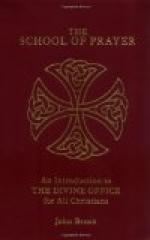Remarks. The Capitulum is said always except from Holy Thursday to the Vespers of Saturday preceding Low Sunday, and in Requiem Offices. In Compline it is said after the Hymn.
The Capitulum of Lauds is ordinarily taken from the beginning of the Epistle of the Mass of the day of the feast. Sext and None generally have their capitula drawn from the middle and end of the same Epistle extract. Terce has generally the same words for the Capitulum, as Vespers and Lauds, because it is the grandest and most sublime of the little Hours. The Capitulum is said without a blessing being sought, because it is (in choir) read by the Hebdomadarius, who there represents the person of Christ, just as the Capitulum does too, and for Whom it would not be consonant to ask a blessing. It concludes without Tu autem, because these words are correlative of Jube. And since it is such a short lesson it is easy to recite it without fault or sin, the more so as it is read by the Hebdomadarius, who should be advanced in perfection. It is short, whilst the lessons of Matins, the night Office, are long, because the day is specially given to toil and the night to contemplation. During the recital of this little lesson all turn to the altar through respect for Christ, figured by the Capitulum. Sometimes the words of the Capitulum are from the Itala version and not from the Vulgate.
Psalms and Canticles of Lauds. The Office of Lauds now consists of four Psalms and a canticle, followed by a little chapter, a hymn, versicle, antiphon, of Benedictus, the canticle, Benedictus and prayer. One of the characteristics of Lauds is the canticle taken from the Old Testament. Fourteen canticles taken from the Old Testament now find a place in our Breviaries. Formerly, only seven canticles from the Old Testament were given in the Psaltery (cf. supra, p. 149).
“If, according to the new distribution of the Psalter, the Psalms for Lauds do not refer so directly to the symbolism of sunrise, they are nevertheless more varied and are generally well chosen. The canticles inserted among the Psalms have also been changed. The whole selection is worthy of note. It contains, besides those given in the former arrangement of the Psalter, others which are very beautiful and admirably prayerful.
“The hymns for Lauds, all ancient and varying with the seasons, form a fine collection. Their theme is one: the rising of the sun as a symbol of Christ’s resurrection, and the crowing of the cock, which arouses the sluggish and calls all to work. Some of these hymns are of considerable poetical merit: that for Sunday, Aeterne Rerum conditor, is a little masterpiece.
“The ‘Benedictus’ corresponds with the Magnificat of Vespers. Both are sung with the same solemnity and are of the same importance; they form as it were the culminating point of their respective Hours, and for feast days the altar is incensed while they are chanted.




